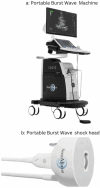Burst wave lithotripsy - a paradigm shift: inferences from a scoping review
- PMID: 40278907
- PMCID: PMC12031800
- DOI: 10.1007/s00345-025-05645-x
Burst wave lithotripsy - a paradigm shift: inferences from a scoping review
Abstract
Purpose: Urolithiasis, a condition affecting approximately 10% of the global population, is primarily treated with Shock Wave Lithotripsy (SWL) and endoscopic methods. However, SWL's high-pressure pulses can cause tissue injury, often necessitates some level of anaesthesia, and may require repeated sessions or ancillary treatment to achieve stone free status. Burst Wave Lithotripsy (BWL) emerges as a promising alternative, utilizing multi-cycle, ultrasound bursts at lower pressure amplitude to fragment stones, while minimizing cavitation under real-time imaging in a portable manner.
Methods: This scoping review evaluated BWL's efficacy, safety, and clinical potential. A systematic search identified 19 eligible studies, including in vitro experiments, preclinical trials, and human clinical trials.
Results: In vitro studies demonstrated BWL's capability to fragment urinary stones of diverse compositions with high comminution rates. Higher ultrasound frequencies produced smaller fragments (< 1 mm), while lower frequencies resulted in larger fragments (3-4 mm), allowing for controlled fragmentation tailored to clinical needs. Preclinical trials in porcine models showed lower pressure and reduced cavitation, which account for BWL's safety, causing less associated tissue injury even in anticoagulated subjects. Human trials reported BWL as well tolerated in awake patients with high fragmentation success rates (88-91%) and low complication rates. BWL offers distinct advantages, including lower cavitation and tissue injury risks, portability, and anaesthesia-free application. Ongoing trials aim to validate BWL's efficacy and explore its combined use with ultrasonic propulsion.
Conclusion: BWL represents a paradigm shift in lithotripsy, offering controlled fragmentation, reduced tissue injury, fragment propulsion and portability for office-based or ambulatory care. Early clinical evidence underscores its safety and efficacy, even in anticoagulated patients. While large-scale trials are needed to solidify its role, BWL's procedural flexibility positions it as a transformative alternative to SWL, poised to redefine urolithiasis management.
Keywords: Break wave; Burst wave; Lithotripsy; Nephrocalcinosis; Shock wave; Ultrasound propulsion.
© 2025. The Author(s).
Conflict of interest statement
Declarations. Ethical approval: Ethics approval is not required in this study. Financial disclosures: All other authors have no relevant financial or non-financial interests to disclose. Competing interests: The authors declare no competing interests.
Figures
Similar articles
-
Combined Burst Wave Lithotripsy and Ultrasonic Propulsion for Improved Urinary Stone Fragmentation.J Endourol. 2018 Apr;32(4):344-349. doi: 10.1089/end.2017.0675. Epub 2018 Mar 20. J Endourol. 2018. PMID: 29433329 Free PMC article.
-
First In-Human Burst Wave Lithotripsy for Kidney Stone Comminution: Initial Two Case Studies.J Endourol. 2021 Apr;35(4):506-511. doi: 10.1089/end.2020.0725. Epub 2020 Nov 5. J Endourol. 2021. PMID: 32940089 Free PMC article. Clinical Trial.
-
In Vitro Evaluation of Urinary Stone Comminution with a Clinical Burst Wave Lithotripsy System.J Endourol. 2020 Nov;34(11):1167-1173. doi: 10.1089/end.2019.0873. Epub 2020 Mar 20. J Endourol. 2020. PMID: 32103689 Free PMC article.
-
Technological innovations in shock wave lithotripsy.Actas Urol Esp (Engl Ed). 2024 Jan-Feb;48(1):105-110. doi: 10.1016/j.acuroe.2023.09.001. Epub 2023 Oct 17. Actas Urol Esp (Engl Ed). 2024. PMID: 37858618 Review. English, Spanish.
-
Shock wave lithotripsy: the new phoenix?World J Urol. 2015 Feb;33(2):213-21. doi: 10.1007/s00345-014-1369-3. Epub 2014 Aug 1. World J Urol. 2015. PMID: 25081010 Review.
References
-
- Abufaraj M, Xu T, Cao C, Waldhoer T, Seitz C, D’Andrea D et al (2021) Prevalence and trends in kidney stone among adults in the USA: analyses of National health and nutrition examination survey 2007–2018 data. Eur Urol Focus 7(6):1468–1475. 10.1016/j.euf.2020.08.011 - PubMed
-
- Pace KT, Ghiculete D, Harju M, Honey RJ, University of Toronto Lithotripsy A (2005) Shock wave lithotripsy at 60 or 120 shocks per minute: a randomized, double-blind trial. J Urol 174(2):595–599. 10.1097/01.ju.0000165156.90011.95 - PubMed
-
- Eisenmenger W (2001) The mechanisms of stone fragmentation in ESWL. Ultrasound Med Biol 27(5):683–693. 10.1016/s0301-5629(01)00345-3 - PubMed
-
- Howard D, Sturtevant B (1997) In vitro study of the mechanical effects of shock-wave lithotripsy. Ultrasound Med Biol 23(7):1107–1122. 10.1016/s0301-5629(97)00081-1 - PubMed
Publication types
MeSH terms
LinkOut - more resources
Full Text Sources


